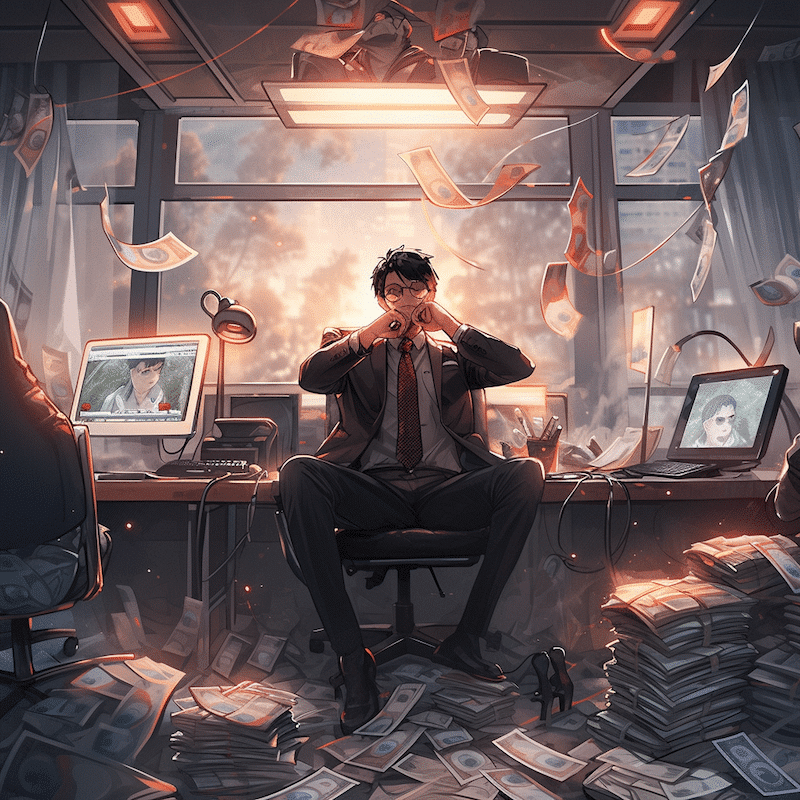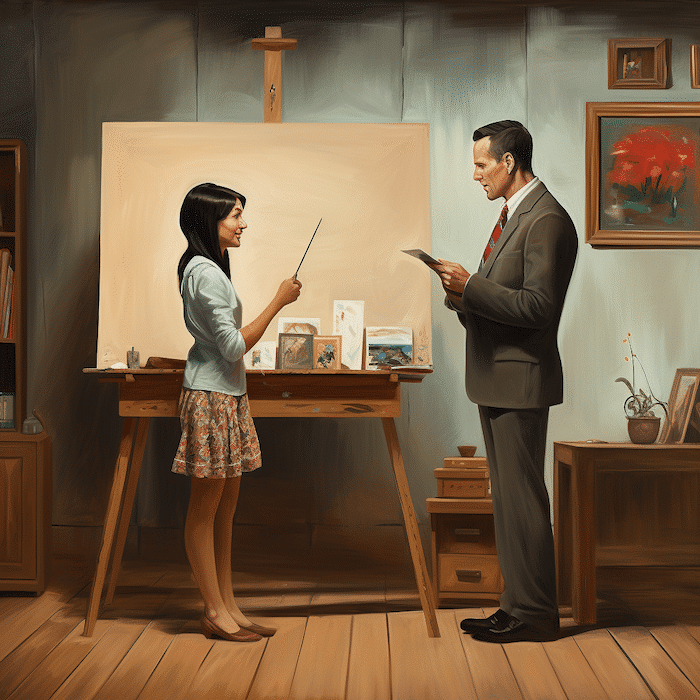Imagine walking through a department store and discovering that one of your paintings is being used as a graphic on a t-shirt. The first response is usually, “I am going to sue this company.” While that may be the intention, the reality is that in many cases, the legal costs associated with suing for copyright infringement can be more expensive than what an artist can receive from winning the case.
Fortunately, copyright law has a mechanism known as statutory damages that can significantly influence the potential financial outcome of a lawsuit in the artist’s favor. In this article, we’ll delve into the intricacies of statutory damages, a topic that every artist should understand to protect their creative work.
The Traditional Challenge: Non-Statutory Damages
Engaging in a copyright lawsuit isn’t a decision to be taken lightly. It involves a complex process where both plaintiffs (the ones who bring the lawsuit) and defendants (the ones being sued) must weigh the potential award (the money they could win) against the costs and efforts required to reach a resolution.
In traditional copyright infringement lawsuits, known as non-statutory damages suits, the road to compensation can be long, expensive, and uncertain. The copyright holder is only entitled to receive actual damages along with the profits made by the infringer from the portion of the sale that can be attributed to the artwork.
When determining profit, you need to know things like how many of the items were sold, over what period, what the cost to make them is, and the sale price, among other things. Those details are often private and require initiating a lawsuit and paying hefty attorney’s fees just to compel the infringer to give up this information. This process is known as Discovery, the phase in a lawsuit where each party can obtain evidence from the opposing party, such as accounting books and sales figures.
Determining the profit attributed to the work is also very tricky, often requiring expensive expert witnesses from both sides to argue over the value. Let’s look at an example to help explain the concept:
Imagine you find your work on a package for a set of candles in a department store. The artist would be entitled to the licensing fee they would have received if they authorized the use, which are the actual damages. Disacovery will identify how many were sold, which helps determine the licensing fee as well as the profit. However, they purchases are for candles, not the artwork, so you then have to determine the portion of the profit that came from the use of the artwork. In this example, we have to look at all the reasons that people bought the candles, such as the candle shape, color, design or even the reputation of the company that produced the candle and decide what portion of the purchase was because the artwork on the package looked enticing.
Furthermore, profit is defined as the sale price minus costs. Some costs are easy to define, such as what it costs to ship each item, but other costs are much harder, such as a marketing or advertising campaign that may include multiple product lines. Determining what costs can be deducted from the profit is often a contentious and protracted battle between attorneys, leading to even more legal fees.
For all these reasons, non-statutory damages are always time-consuming, difficult, and costly. The uncertainty and potential risks involved can deter many artists from pursuing their rightful compensation.
Unlocking Profitable Copyright Lawsuits with Statutory Damages

Statutory damages can bring artists a lot more money in a copyright lawsuit
Statutory damages are a unique feature of copyright law, designed to provide a more straightforward and predictable path to compensation. It was created to address the challenges and uncertainties of calculating actual damages and determining profits in copyright infringement cases.
There is no need to present proof of damages or profits in a statutory damages case. Instead, the law provides a range of damages that can be awarded for each work infringed, regardless of the actual damages or profits involved. Under statutory damages, the copyright holder will be awarded between $750 and $30,000 per infringement and up to $150,000 if the infringement was willful.
But here is the kicker: the infringer must also pay your legal fees. This also helps reduce the time it takes to try the case because each day that the lawsuit continues, requiring lawyers to make motions, invoke various legal procedures, or fight over evidence and discovery, the infringer is racking up two sets of legal fees! So there is an incentive for the infringer to settle the case early by giving the artist a proper award.
Moreover, statutory damages can make it so that you won’t even have to lay out legal fees because most intellectual property attorneys will take the case “on contingency.” A contingency fee is a payment arrangement that allows the artist to obtain legal representation and not pay the lawyer until the case is concluded.
The lawyer agrees to accept a fixed percentage (often one-third) of the recovery, which is paid to the lawyer only if the lawsuit is successful or is favorably settled out of court. If the client loses the case, the lawyer gets no fee. However, the client may still be responsible for costs and expenses related to the case.
In the context of copyright infringement cases, if the case is taken on contingency, the lawyer might be paid out of the statutory damages awarded, which can include the lawyer’s fees. This arrangement can make it easier for copyright holders to pursue their cases, as they don’t have to worry about paying high legal fees upfront.
The Big Caveat: Statutory Damages Require Registration with the U.S. Copyright Office
So why doesn’t everyone invoke statutory damages? Statutory damages are only available if the work is registered with the U.S. Copyright Office before the infringement occurs or within three months of publication. For example, if you put your work online and it was infringed one month later and you had not registered the work, you would still have two months to register. Of course, if you discovered the infringement three months later and had not registered it, you are out of luck.
The Impact of Willful Infringement
As mentioned earlier, willful infringement can increase the damage award to $150,000 per infringement. Willful infringement is a term used in copyright law to describe a situation where someone knowingly and intentionally infringes on another’s copyright. However, proving purposeful intent can be difficult without direct evidence that they knew the work was stolen, such h as finding text or emails of their wilfulness during discovery. In reality, willful infringement is rare. Many infringers don’t understand copyright law or may have purchased the pieces not knowing they were infringing, such as the candle example discussed earlier.
A willful infringement usually occurs when the artist asks the infringer to remove the infringing items and is provided proof that the work is infringing, and yet, they still refuse to remove the infringing pieces. That intentional act can invoke willful damages.
Copyright Registration: An Artist’s Insurance Policy
In the realm of copyright law, statutory damages can be seen as an insurance policy for artists. By registering your work, you’re strengthening your legal rights and potentially setting yourself up for a more straightforward and lucrative path should you ever need to pursue a copyright infringement lawsuit. The cost of registering a work is relatively low, especially when compared to the potential benefits it can provide in an infringement case. For more on the copyright registration process, see Planning for Copyright Registration.
In essence, copyright registration acts as a safeguard, a form of insurance that can provide significant financial benefits in the event of copyright infringement. It’s a small step that can significantly impact the protection of your creative work.
The Role of a Copyright Attorney: Your Guide in the Legal Maze
Navigating the legal maze of a copyright infringement lawsuit can be daunting, especially for artists who are more accustomed to creating than litigating. This is where a copyright attorney comes into play. A copyright attorney is not just a legal representative; they are your guide, advisor, and advocate in the complex world of copyright law.
If your work has been registered with the U.S. Copyright Office, a copyright attorney can potentially take your case on a contingency basis. However, if your work has not been registered, the dynamics change. In such cases, the attorney may be unable to take the case on contingency due to the uncertainty and potential challenges associated with proving actual damages.
However, a good Intellectual Property (IP) Attorney should be able to provide you with the expected range of costs and potential risks associated with your case. This can help you make an informed decision about whether to proceed with the lawsuit.
It’s important to note that not all attorneys are created equal. Copyright law is a specialized field with its own set of rules and nuances. A general practice attorney may not have the in-depth knowledge and experience required to navigate a copyright infringement lawsuit effectively, so consult an IP attorney when considering a copyright lawsuit.

Always consult an experienced copyright. The right legal advice can make all the difference in a copyright infringement lawsuit.
——-
While the world of copyright law can seem intimidating, understanding the concept of statutory damages can empower artists to protect their work and pursue their rightful compensation. Remember, copyright registration acts as an insurance policy, potentially setting you up for a more straightforward and lucrative path should you ever need to pursue a copyright infringement lawsuit. It’s a small step that can greatly impact the protection of your creative work.
Have you been in a copyright infringement lawsuit with statutory damages? Tell us about your experience in the comments.
